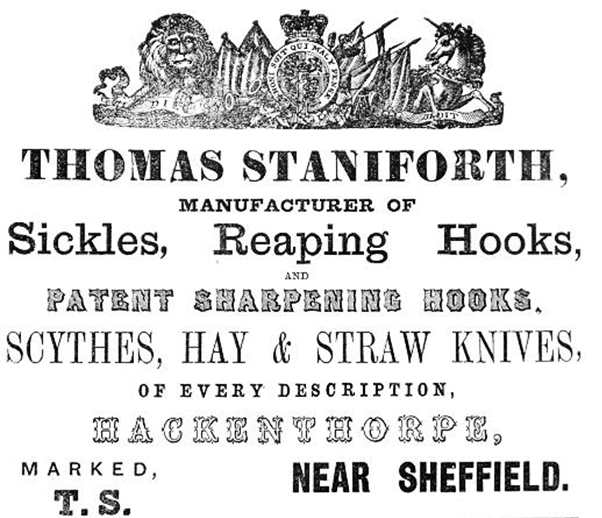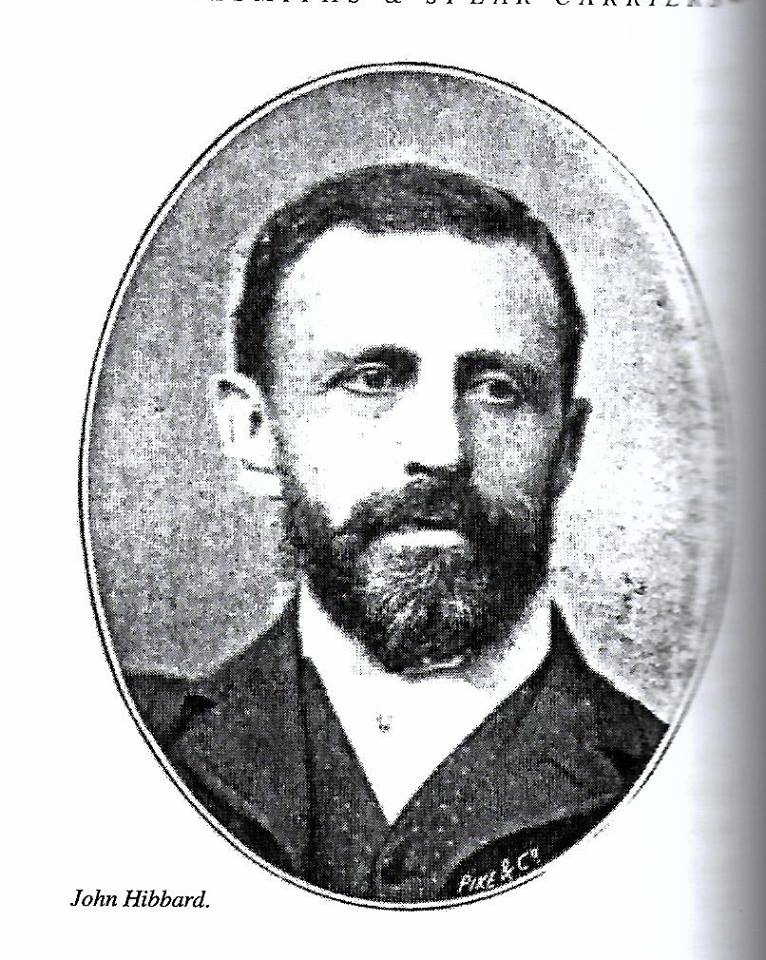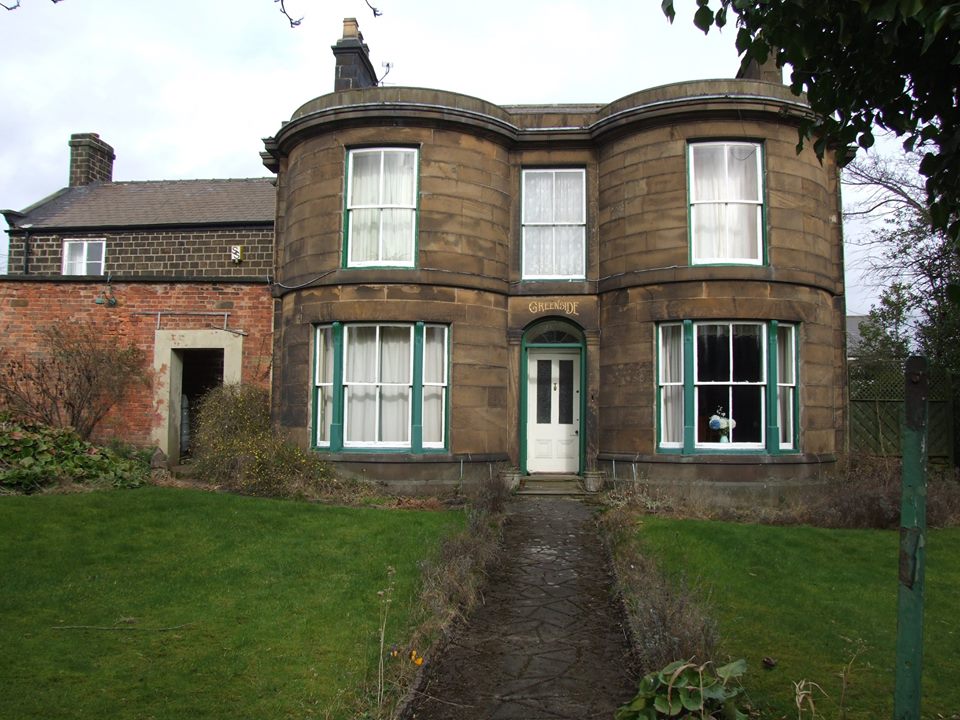
Thomas Staniforth & Co. Sickle works at Hackenthorpe.
 Thomas' mark on his will dated 1873
Thomas' mark on his will dated 1873
Thomas Staniforth IV was baptised at St. Mary’s Beighton on June 24th, 1810 to Thomas Staniforth and Ann Hibbard. Thomas took after his father and learned the Sickle and scythe smithing trade.
On December 3rd 1835 Thomas married Mary Jane Hardy in the neighbouring parish of Eckington. Mary was baptised on August 4th 1811 and was the daughter of Dr. Robert Hardy of Eckington and Elizabeth North.
Thomas and Elizabeth had ten children together:
When Thomas Staniforth’s father passed away in 1847, Thomas and Mary Jane moved into Greenside House, next to the family Sickle and Scythe works at Hackenthorpe. In his will, Thomas’ father stated that he intended for his son to take over the business and in return he would receive one fourth part of the net profits above any wages that the trustees of his father’s will would agree to pay him. When each of Thomas’ siblings had reached a mature age, the business was given up to a partnership consisting of Thomas, and his brothers John and Hugh.
In 1848, the village of Hackenthorpe was quite literally shook. It was in the early hours of the first Saturday in October, when the inhabitants of Hackenthorpe were rudely woken by a violent explosion on Brook Lane. It is easy to imagine the commotion in the village that morning, inhabitants from Main Street and Brook Lane rushing from their homes on hearing the loud explosion, and the sound of glass shattering.
The home which was soon discovered to be the scene of the crime, was the home of Alfred and William Lee, where an attempt to blow up their home had failed. The makeshift explosive was created using a piece of Iron pipe which had been charged with gunpowder. The pipe was then thrown through one of the low windows, however the shutters obstructed it from entering causing it to rebound back to the exterior pavement. When the device exploded it caused damage to the stone pavement as well as a number of neighbouring windows on Brook Lane.
The Lee family were sickle-makers employed by Thomas Staniforth, they were targeted for agreeing to work for reduced pay. Many other workers from the time had refused to work and had been striking for over a month.
Another curious incident took place four years following this attack. A man named John Webster, who was 38 at the time, and another Sickle Grinder from Hackenthorpe, went with two fellow workmen, Alexander Barker and George Staniforth of The New Inn to the Brampton-le-Morthen Feast. They entered the Rising Deer Inn where the Sheffield Harriers were meeting and it was discovered the party had a loaded gun with them. Alexander Barker pulled the gun into pieces and put the stock into his jacket John Webster sat in a chair observing the situation. Barker then bent down into the fireplace to light his pipe when the barrels fell from his pocket. One of the barrels exploded, with shrapnel being lodged into John Webster's abdomen and thigh. He died within 20 minutes. An accidental verdict was given at the Inquest.
By this time Thomas was not only in possession of The New Inn, but also two other properties in Hackenthorpe. George, the victualler involved in the accident at The Rising Deer, was Thomas’ cousin, the son of James Staniforth, another victualler that ran The Boot and Shoe (Later named The Blue Bell) before moving to The New Inn.On the 1851 Census, Thomas is recorded as employing 128 men. During this time period, the lifestyle would have been very fast paced compared to the times of Thomas’ ancestors. The Railway had arrived in Beighton during the 1840s and the Sickleworks was producing about 30,000 sickles a year.
Sickles, Scythes and other tools produced by Thomas Staniforth were shipped all around the world, with trade marks registered in Austria, Holland, Hungary, India, Russia and New Zealand.
 John Hibbard
John Hibbard
1851 was also the year of the Great Exhibition in London with many firms from Sheffield being on display including Turton & Sons of the Sheaf Works, their display was arranged by Frederick Ward, the son of Thomas Asline Ward, politician and a member of the Younge family. The Younge’s married into the Darnall branch of Staniforths.
Thomas Staniforths of Hackenthorpe was not only on display, but was also awarded prizes. This was recorded on letterheads at the time, where the company proudly noted:
‘The Prize Medal at the Great Exhibition, 1851’
Thomas’ cousin, Rowland Staniforth’s firm was also on display at the exhibition.
By the mid-1850s, the Crimean War was in full swing, however Thomas was fighting his own battles in Hackenthorpe. Thomas was the Churchwarden, and had made a complaint to the police regarding people blocking the approach to the school and church, however he was told there could be nothing done unless he could get the names of the offenders. One Sunday in April, Thomas walked the footpath and made an attempt to record names and ordered the men to move. Two men, William Brammall and John Turner refused. When Thomas used physical force to remove the men, William struck him in the face and Turner kicked him. The men were both fined £5 which at the time would have been many weeks’ wages. William Bramall made arrangements to pay the fine, however John Turner claimed that he would rather be incarcerated, and was imprisoned for two months.
A significant event occurs in 1864. Throughout the Staniforth Sickle and Scytheworks long history, no fatalities were recorded, however this year a grind stone at Cliff Wheel was reported to have ‘burst’ and the grinder sustained fatal injuries that killed him a few days later. The accident was deemed to have been caused by poor conditions at Cliff Wheel, and workers then refused to work at this location. In a letter dated 27th August 1864m Thomas sent a message to Lord Manvers agent John Horncastle regarding the state of Cliff Wheel. He stated that even if the machinery was replaced at the cost of £200-£300 that there was not sufficient water. He removed all of his tools and requested that his tenancy of Cliff Wheel be revoked..
Thomas made it clear that with the current water levels, the wheel could only be used for one work day a week, however Horncastle’s response was rather stern. He told Thomas that in his opinion the £10 a year fee that Thomas was paying for the wheel was more than satisfactory and that he would essentially be crazy if he ended his occupation.
Although it is unclear how Thomas responded, it seems that he was in agreement as the Staniforth’s leased the wheel for a further 15 years following this incident.
Two years later in 1866, Thomas Staniforth, Thomas’ eldest son died at the age of Twenty-nine. This ended the long line of the company being passed to the eldest son.
In the early 1870s Thomas Staniforth bought the business of Mr. George Helliwell, another local Sickle and Scythe smith that operated at the nearby Throstlenest Farm at Hackenthorpe. In 1865, it was recorded that George Helliwell was the only competitor to Thomas Staniforth in the village and in 1865 he took out a 21 year lease on the farm, which cost him an annual fee of £40. He was crafting Scythes, hooks and knives and two of his workers were named Thomas and John Martin of Main Street. Scythes were carried by horse down to the Cliff Wheel to be ground and then brought back to the farm.
 Greenside House, Hackenthorpe
Greenside House, Hackenthorpe
The business was forced to close due to complaints regarding the noise of the blast furnace. Horses passing by the farm were startled at the sound of the furnace, this effectively paved the way for the company to be absorbed by Thomas Staniforth.
By the end of 1872, Thomas officially turned his manufactory into a company. John and Hugh, his younger brothers that were named in their fathers will were now deceased. Thomas decided to take up partnership with his son William Staniforth, and his son in law John Hibbard, the wife of his daughter Louisa Staniforth, and Rowland Hibbard, the husband of his daughter Harriet Ann Staniforth. Rowland was John Hibbards brother, serving as a captain in the Sheffield Artillery Volunteers. He would only live another two years, passing away aged thirty one.
It should be noted that John and Rowland were the sons of John Hibbard and Hannah Hibbard (cousins) and that Johns’ father Rowland Hibbard of Woodhouse was trustee to Mary Staniforth (nee Hurt)s will. Thomas Staniforth’s own mother Ann Hibbard was also a member of this line of Hibbards.
Thomas Staniforth passed away on September 24th, 1873. His widow Mary Jane Staniforth remained at Greenside House, however at the time of her death in 1887, her address was recorded as Brunswick Street, Sheffield. By the time of the 1891 Census, John Hibbard and his family were living at Greenside House.